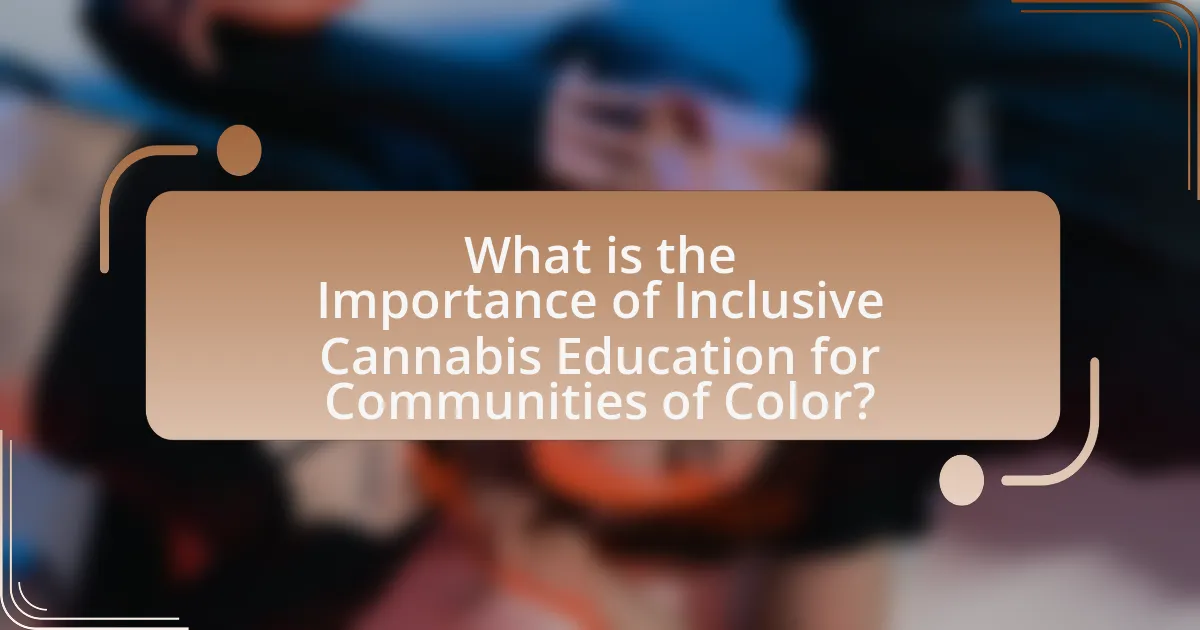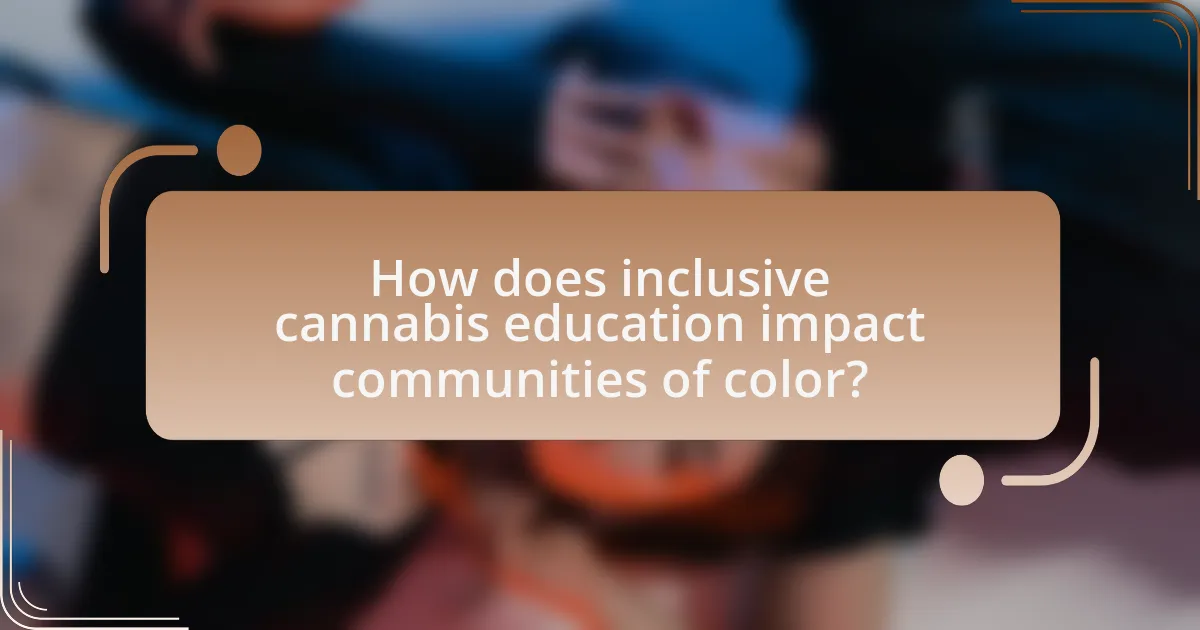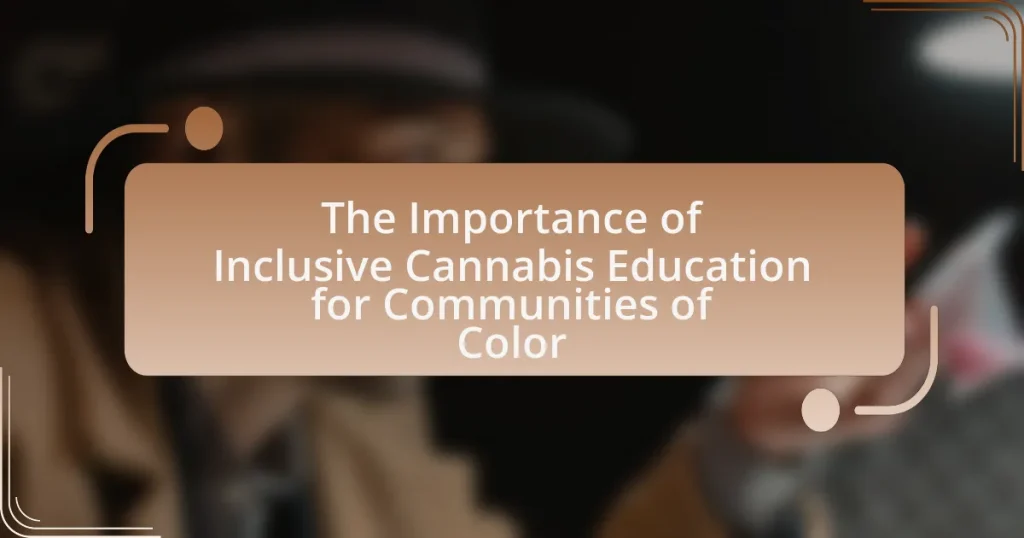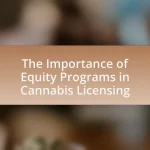The article emphasizes the critical need for inclusive cannabis education specifically tailored for communities of color, addressing historical injustices and promoting equitable access to the cannabis industry. It outlines the disproportionate impacts of cannabis prohibition on these communities, highlighting the importance of education in empowering individuals with knowledge about legal rights, health benefits, and economic opportunities. Key components of effective cannabis education include culturally relevant content, accessibility, and community engagement, which collectively aim to dismantle stigma and foster informed decision-making. The article also discusses the role of community organizations in facilitating education and the challenges faced in implementing these initiatives, ultimately advocating for strategies to enhance accessibility and promote advocacy for inclusive cannabis education.

What is the Importance of Inclusive Cannabis Education for Communities of Color?
Inclusive cannabis education for communities of color is crucial for addressing historical injustices and promoting equitable access to the cannabis industry. This education empowers individuals by providing knowledge about the legal, health, and economic aspects of cannabis, which have often been overlooked in marginalized communities. For instance, according to a 2021 report by the Brookings Institution, communities of color have faced disproportionate impacts from cannabis prohibition, leading to higher incarceration rates and limited economic opportunities. By fostering inclusive education, these communities can better navigate the evolving cannabis landscape, advocate for their rights, and participate in the economic benefits of legalization.
Why is inclusive cannabis education necessary for communities of color?
Inclusive cannabis education is necessary for communities of color to address historical injustices and ensure equitable access to the benefits of cannabis legalization. Communities of color have been disproportionately affected by cannabis prohibition, facing higher rates of arrest and incarceration. For instance, a 2020 report from the American Civil Liberties Union found that Black individuals are 3.64 times more likely to be arrested for cannabis possession than white individuals, despite similar usage rates. By providing inclusive education, these communities can gain knowledge about their rights, the legal landscape, and the potential health benefits of cannabis, empowering them to participate in the emerging cannabis industry and advocate for fair policies. This education also helps dismantle stigma and promotes informed decision-making regarding cannabis use and its implications for health and wellness.
What historical factors contribute to the need for inclusive cannabis education?
The historical factors contributing to the need for inclusive cannabis education include the legacy of racial discrimination in drug policy and the disproportionate impact of cannabis prohibition on communities of color. The War on Drugs, initiated in the 1980s, led to the criminalization of cannabis use, disproportionately affecting Black and Latino populations, who faced higher arrest rates despite similar usage patterns compared to white individuals. This systemic inequality has created a knowledge gap regarding cannabis benefits and legal rights within these communities. Furthermore, the stigmatization of cannabis use has historically marginalized voices from communities of color in discussions about cannabis policy and education, necessitating a more inclusive approach to ensure equitable access to information and resources.
How does systemic inequality affect access to cannabis education?
Systemic inequality significantly limits access to cannabis education, particularly for marginalized communities. Factors such as socioeconomic status, racial discrimination, and geographic location create barriers to obtaining accurate information about cannabis use, benefits, and legal implications. For instance, communities of color often face reduced access to educational resources due to historical disenfranchisement and ongoing disparities in funding for public education. According to a report by the American Civil Liberties Union, Black individuals are nearly four times more likely to be arrested for cannabis-related offenses than white individuals, which further perpetuates misinformation and stigma surrounding cannabis in these communities. This lack of access to education not only hinders informed decision-making but also exacerbates health disparities and limits economic opportunities in the cannabis industry.
What are the key components of inclusive cannabis education?
The key components of inclusive cannabis education include culturally relevant content, accessibility, community engagement, and harm reduction strategies. Culturally relevant content ensures that the information reflects the experiences and needs of diverse communities, particularly communities of color, which have historically been marginalized in cannabis discussions. Accessibility involves providing educational resources in multiple languages and formats to reach a broader audience. Community engagement emphasizes collaboration with local organizations and leaders to foster trust and relevance in educational initiatives. Harm reduction strategies focus on educating individuals about safe consumption practices and the potential risks associated with cannabis use, thereby promoting informed decision-making. These components collectively contribute to a more equitable and effective approach to cannabis education.
What topics should be covered in cannabis education programs?
Cannabis education programs should cover topics such as the history of cannabis, its legal status, health effects, responsible use, and social justice implications. The history of cannabis includes its cultural significance and the impact of prohibition, which is crucial for understanding current legal frameworks. The legal status of cannabis varies by region, making it essential to educate individuals on local laws and regulations. Health effects encompass both the medicinal benefits and potential risks associated with cannabis use, providing a balanced view. Responsible use education promotes safe consumption practices, while social justice implications address the disparities faced by communities of color due to past cannabis policies. These topics are vital for fostering informed and equitable discussions around cannabis in diverse communities.
How can cultural relevance enhance cannabis education for communities of color?
Cultural relevance can enhance cannabis education for communities of color by ensuring that the information is relatable, accessible, and reflective of their unique experiences and histories. Tailoring educational content to address the specific cultural contexts, values, and concerns of these communities fosters greater engagement and understanding. For instance, studies show that culturally tailored health interventions can improve knowledge retention and behavioral change, as seen in the work by the American Public Health Association, which emphasizes the importance of culturally competent health education. By incorporating culturally relevant narratives and examples, cannabis education can effectively dismantle stigma, promote responsible use, and empower individuals within these communities to make informed decisions regarding cannabis.
What role do community organizations play in cannabis education?
Community organizations play a crucial role in cannabis education by providing accessible information and resources tailored to the needs of specific communities. These organizations often address the historical context of cannabis use and its legal implications, particularly in communities of color that have been disproportionately affected by cannabis prohibition. For instance, studies show that community-led initiatives can increase awareness about safe consumption practices and the benefits of cannabis, while also combating stigma. Furthermore, organizations like the Minority Cannabis Business Association advocate for equitable policies and support education programs that empower individuals with knowledge about cannabis legislation and health impacts. This targeted approach ensures that education is relevant and culturally sensitive, fostering informed decision-making within these communities.
How can partnerships with local organizations improve educational outreach?
Partnerships with local organizations can significantly enhance educational outreach by leveraging community trust and resources. Local organizations often have established relationships with community members, which facilitates better engagement and communication. For instance, a study by the National Institute on Drug Abuse highlights that community-based organizations can effectively disseminate information tailored to the specific needs and cultural contexts of their populations, thereby increasing the relevance and impact of educational initiatives. Additionally, these partnerships can provide access to local venues, volunteers, and networks, which can amplify outreach efforts and ensure that educational programs reach a broader audience.
What strategies can organizations use to engage communities effectively?
Organizations can engage communities effectively by implementing inclusive educational programs tailored to the specific needs and cultural contexts of those communities. For instance, providing workshops that focus on the benefits and risks of cannabis use, particularly in communities of color, fosters understanding and trust. Research indicates that culturally relevant education increases participation and retention rates, as seen in studies conducted by the National Institute on Drug Abuse, which highlight the importance of culturally competent approaches in health education. Additionally, forming partnerships with local leaders and organizations enhances credibility and outreach, ensuring that the information disseminated resonates with community values and experiences.

How does inclusive cannabis education impact communities of color?
Inclusive cannabis education positively impacts communities of color by providing essential knowledge that empowers individuals to make informed decisions about cannabis use and its legal implications. This education helps to dismantle stigma, promotes health literacy, and encourages responsible consumption, which is crucial in communities disproportionately affected by the War on Drugs. For instance, research from the Drug Policy Alliance indicates that access to accurate cannabis information can lead to better health outcomes and reduced rates of incarceration related to cannabis offenses in these communities. Furthermore, inclusive education initiatives can foster economic opportunities by preparing individuals for careers in the legal cannabis industry, which has been shown to create jobs and stimulate local economies.
What benefits does inclusive cannabis education provide to individuals?
Inclusive cannabis education provides individuals with essential knowledge that empowers informed decision-making regarding cannabis use and its legal implications. This education helps demystify cannabis, reducing stigma and promoting understanding of its medicinal and recreational benefits. Research indicates that individuals who receive comprehensive cannabis education are more likely to engage in responsible usage, leading to improved health outcomes and reduced legal risks. Furthermore, inclusive education addresses historical injustices and disparities in access to information, fostering a more equitable environment for communities of color. By equipping individuals with accurate information, inclusive cannabis education enhances personal agency and promotes community well-being.
How does education empower individuals in making informed choices about cannabis?
Education empowers individuals to make informed choices about cannabis by providing them with accurate information regarding its effects, legal status, and potential health implications. This knowledge enables individuals to understand the differences between various cannabis products, including THC and CBD concentrations, and their respective impacts on health and wellness. Research indicates that informed individuals are more likely to engage in responsible usage and avoid potential risks associated with cannabis consumption. For instance, a study published in the Journal of Psychoactive Drugs found that education significantly reduces misconceptions about cannabis, leading to more responsible decision-making among users.
What role does education play in reducing stigma around cannabis use?
Education plays a crucial role in reducing stigma around cannabis use by providing accurate information and fostering understanding. By educating individuals about the benefits and risks associated with cannabis, misconceptions can be addressed, leading to a more informed public perception. Research indicates that educational programs that include evidence-based information about cannabis can significantly alter attitudes; for instance, a study published in the Journal of Drug Issues found that participants who received comprehensive cannabis education reported lower levels of stigma compared to those who did not. This shift in perception is essential for communities of color, where stigma can disproportionately affect access to resources and equitable treatment.
How can inclusive cannabis education contribute to economic opportunities?
Inclusive cannabis education can significantly contribute to economic opportunities by equipping marginalized communities with the knowledge and skills necessary to participate in the cannabis industry. This education fosters entrepreneurship, enabling individuals to start their own businesses, such as dispensaries or cultivation operations. For instance, a report by the National Cannabis Industry Association indicates that the legal cannabis market is projected to reach $41.5 billion by 2025, presenting substantial economic potential for those educated in the field. Furthermore, inclusive education programs can help reduce barriers to entry, such as understanding regulatory compliance and business management, thereby increasing job creation and economic empowerment within communities of color.
What job opportunities arise from a well-informed community regarding cannabis?
A well-informed community regarding cannabis creates job opportunities in various sectors, including legal consulting, retail management, cultivation, and education. Legal consulting roles arise as individuals and businesses seek guidance on compliance with cannabis regulations, which are complex and vary by jurisdiction. Retail management positions become available in dispensaries that require knowledgeable staff to assist customers and ensure compliance with laws. Cultivation jobs emerge in the agricultural sector, where skilled workers are needed to grow and harvest cannabis plants. Additionally, educational roles in community outreach and training programs develop to inform the public about cannabis use, benefits, and legalities. These opportunities contribute to economic growth and empower communities, particularly in areas historically affected by cannabis prohibition.
How can education facilitate entrepreneurship in the cannabis industry?
Education can facilitate entrepreneurship in the cannabis industry by providing essential knowledge about regulations, business management, and market trends. This knowledge equips aspiring entrepreneurs with the skills needed to navigate the complex legal landscape and develop viable business strategies. For instance, educational programs that focus on compliance with state laws and federal regulations can significantly reduce the risk of legal issues, which is crucial in an industry that is still evolving. Furthermore, access to training in financial literacy and marketing can empower individuals to create sustainable business models. Research from the National Cannabis Industry Association indicates that businesses led by individuals with formal education in cannabis-related fields are more likely to succeed, highlighting the importance of education in fostering a robust entrepreneurial ecosystem within the cannabis sector.

What challenges exist in implementing inclusive cannabis education?
Implementing inclusive cannabis education faces several challenges, primarily stemming from systemic barriers, cultural stigmas, and a lack of resources. Systemic barriers include historical inequities in access to education and information about cannabis, particularly for communities of color, which have been disproportionately affected by cannabis prohibition. Cultural stigmas surrounding cannabis use can hinder open discussions and acceptance of cannabis education within these communities. Additionally, a lack of funding and resources for educational programs limits the ability to develop and disseminate inclusive curricula that address the specific needs and concerns of diverse populations. These challenges collectively impede the effectiveness of cannabis education initiatives aimed at fostering understanding and responsible use among marginalized groups.
What barriers do communities of color face in accessing cannabis education?
Communities of color face significant barriers in accessing cannabis education, primarily due to systemic inequities, lack of resources, and cultural stigmas. Systemic inequities manifest in limited access to educational programs and materials, often exacerbated by socioeconomic factors that hinder participation. For instance, a report from the American Civil Liberties Union highlights that communities of color are disproportionately affected by cannabis-related arrests, which contributes to a lack of trust in cannabis-related institutions and education. Additionally, many educational resources are not culturally relevant or accessible, further alienating these communities. Cultural stigmas surrounding cannabis use also deter individuals from seeking out educational opportunities, as negative perceptions persist within these communities.
How do legal restrictions impact educational initiatives?
Legal restrictions significantly hinder educational initiatives by limiting access to information and resources necessary for effective learning. For instance, in regions where cannabis remains illegal, educational programs about its benefits and risks are often restricted, preventing communities from receiving accurate and comprehensive information. This lack of access can perpetuate misinformation and stigma, particularly in communities of color that may already face systemic barriers to education. Research indicates that states with more progressive cannabis laws tend to have more robust educational initiatives, highlighting the correlation between legal frameworks and the quality of educational outreach.
What funding challenges hinder the development of educational programs?
Funding challenges that hinder the development of educational programs include limited access to financial resources, lack of government support, and competition for grants. Limited access to financial resources restricts the ability of organizations to create and sustain educational initiatives, particularly in underserved communities. Lack of government support often results in insufficient funding allocations for educational programs, which can lead to program discontinuation or reduced quality. Additionally, competition for grants can create barriers, as many organizations vie for the same limited funding sources, making it difficult for new or smaller programs to secure necessary financial backing. These challenges collectively impede the growth and effectiveness of educational programs, particularly those aimed at promoting inclusive cannabis education for communities of color.
How can these challenges be overcome?
To overcome the challenges of inclusive cannabis education for communities of color, targeted educational programs must be developed that address specific cultural and historical contexts. These programs should incorporate community leaders and experts to ensure relevance and relatability, fostering trust and engagement. Research indicates that culturally tailored educational initiatives significantly improve knowledge retention and community participation, as seen in the “Culturally Relevant Health Education” study published in the Journal of Health Education Research & Development, which highlights the effectiveness of such approaches in marginalized communities. By prioritizing accessibility and inclusivity in cannabis education, barriers can be reduced, leading to better-informed communities and equitable participation in the cannabis industry.
What best practices can be adopted to enhance accessibility to cannabis education?
To enhance accessibility to cannabis education, implementing community-based workshops and utilizing multilingual resources are essential best practices. Community-based workshops allow for direct engagement with local populations, fostering a supportive environment where individuals can ask questions and receive tailored information. For instance, studies show that peer-led education significantly increases knowledge retention and comfort levels among participants. Additionally, providing multilingual resources ensures that non-English speakers can access vital information, thereby reducing barriers to understanding cannabis-related topics. Research indicates that language accessibility in educational materials can improve comprehension and participation rates, particularly in diverse communities.
How can advocacy play a role in promoting inclusive cannabis education?
Advocacy can significantly promote inclusive cannabis education by raising awareness and addressing the unique needs of marginalized communities. Through targeted campaigns, advocacy groups can highlight the historical injustices faced by communities of color in relation to cannabis laws and educate these populations about their rights and the benefits of cannabis. For instance, organizations like the Minority Cannabis Business Association work to ensure equitable access to cannabis education and business opportunities, thereby fostering inclusivity. Additionally, advocacy efforts can influence policy changes that support educational programs tailored to the cultural and social contexts of diverse communities, ensuring that information is accessible and relevant.
What are practical steps for communities to implement inclusive cannabis education?
Communities can implement inclusive cannabis education by developing culturally relevant curricula that address the specific needs and concerns of diverse populations. This involves collaborating with local organizations, such as community centers and advocacy groups, to ensure that educational materials reflect the cultural context and historical experiences of communities of color. Additionally, hosting workshops and seminars led by knowledgeable facilitators from within these communities can enhance engagement and trust. Research indicates that culturally tailored education increases retention and understanding, making it more effective (Bennett et al., 2020, Journal of Cannabis Research). Furthermore, providing resources in multiple languages and utilizing various media formats, such as videos and social media campaigns, can broaden accessibility and reach.
How can community members get involved in educational initiatives?
Community members can get involved in educational initiatives by participating in local workshops, volunteering for educational programs, and collaborating with organizations focused on cannabis education. Engaging in these activities allows individuals to share knowledge, support outreach efforts, and contribute to creating inclusive educational environments. For instance, organizations like the Minority Cannabis Business Association provide resources and opportunities for community involvement, emphasizing the importance of representation and education in the cannabis sector.
What resources are available for developing cannabis education programs?
Resources available for developing cannabis education programs include online platforms, community organizations, and educational institutions. Online platforms such as Leafly and NORML provide comprehensive guides and materials tailored for various audiences. Community organizations like the Minority Cannabis Business Association offer resources specifically aimed at educating communities of color about cannabis. Educational institutions, including universities with cannabis studies programs, contribute research and curriculum development support. These resources collectively enhance the accessibility and effectiveness of cannabis education initiatives, particularly for underserved populations.


